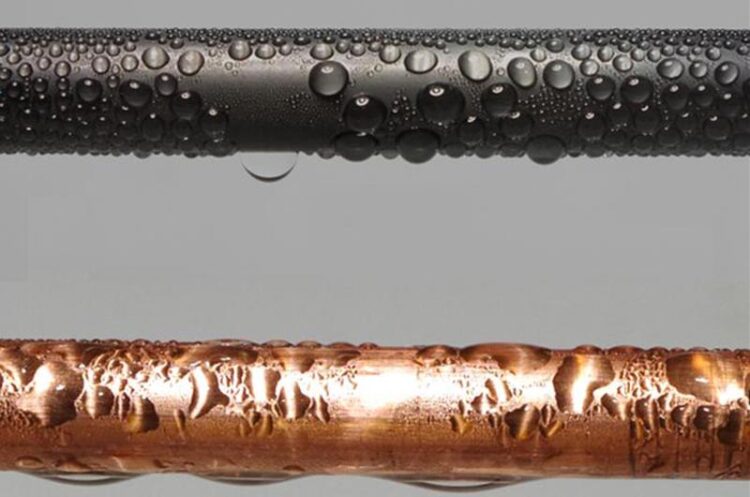Steam condenser coating could save 460M tons of CO2 annually

Copper steam condenser pipes coated with F-DLC (top) and without a coating (bottom). The F-DLC coating allows the condensed water to form into droplets rather than a thin film covering the pipe.
Credit: The Grainger College of Engineering at the University of Illinois Urbana-Champaign
If coal and natural gas power generation were 2% more efficient, then, every year, there could be 460 million fewer tons of carbon dioxide released and 2 trillion fewer gallons of water used. A recent innovation to the steam cycle used in fossil fuel power generation could achieve this.
Researchers at the University of Illinois Urbana-Champaign have developed a coating for steam condensers used in fossil fuel steam-cycle generation that is made with fluorinated diamond-like carbon, or F-DLC. The researchers reported in the journal Nature Communications that this coating could boost the overall process efficiency by 2%. In addition, they demonstrated the coating’s suitability for industrial use by performing the longest durability test ever reported.
“The reality is that fossil fuels aren’t going away for at least 100 years,” said Nenad Miljkovic, a professor of mechanical science & engineering at UIUC and the project lead. “A lot of CO2 is going to be emitted before we get to a place where we can lean on renewables. If our F-DLC coating were adopted globally, it would noticeably curtail carbon emissions and water usage for the existing power infrastructure.”
Fossil fuel power generation depends on a process called the steam cycle, in which fuel is burned to boil water, the resulting steam spins a turbine and the turbine drives an electric generator. The steam then reaches a condenser which both reclaims water from the steam and maintains a pressure difference across the turbine so the steam flows. Improving the condensers’ heat transfer properties would allow a pressure difference to be maintained while burning less fuel.
The researchers’ new F-DLC coating improves heat transfer because the material is hydrophobic. When the steam condenses into water, it does not form a thin film that coats the surface, like water does on many clean metals and their oxides. Instead, the water forms droplets on the F-DLC surface, putting the steam into direct contact with the condenser and allowing heat to be directly transferred. The researchers found that this improved the heat transfer properties by a factor of 20, which translates to a 2% overall process boost.
“It’s remarkable that we can achieve this with F-DLC, something that just uses carbon, fluorene and a little bit of silicon,” said Muhammad Hoque, a postdoctoral research associate and the study’s lead author. “And it can coat pretty much any common metal, including copper, bronze, aluminum and titanium.”
To demonstrate F-DLC’s durability, the researchers subjected coated metals to steam condenser conditions for 1,095 days, the longest test reported in the literature. The coated metals maintained their hydrophobic properties for this entire length of time. The researchers also found that the coated metals maintained their hydrophobic properties after 5,000 scratches in an abrasion test.
The research team is now collaborating with UIUC’s Abbott Power Plant to study the coating’s performance for six months of steady condensation exposure under industrial conditions.
“If all goes well, we hope to show everyone that this is an effective solution that is economically viable,” Miljkovic said. “We want our solution to be adopted, because, although the development of renewable energy should absolutely be a priority, it’s still very worthwhile to continue improving what we have now.”
The researchers’ article, “Ultra-resilient multi-layer fluorinated diamond-like carbon hydrophobic surfaces,” is available online. DOI: 10.1038/s41467-023-40229-6.
F-DLC-coated metals were provided by Oerlikon Balzers Coating.
Researchers from Sabanci University also contributed to this study.
Funding was provided by the Office of Naval Research; the National Science Foundation through the Illinois Materials Research Science and Engineering Center; and the Japanese Ministry of Education, Culture, Sports, Science and Technology.
Journal: Nature Communications
DOI: 10.1038/s41467-023-40229-6
Article Title: Ultra-resilient multi-layer fluorinated diamond-like carbon hydrophobic surfaces
Article Publication Date: 14-Aug-2023
Media Contact
Cassandra Smith
University of Illinois Grainger College of Engineering
casmth11@illinois.edu
All latest news from the category: Materials Sciences
Materials management deals with the research, development, manufacturing and processing of raw and industrial materials. Key aspects here are biological and medical issues, which play an increasingly important role in this field.
innovations-report offers in-depth articles related to the development and application of materials and the structure and properties of new materials.
Newest articles

Trotting robots reveal emergence of animal gait transitions
A four-legged robot trained with machine learning by EPFL researchers has learned to avoid falls by spontaneously switching between walking, trotting, and pronking – a milestone for roboticists as well…

Innovation promises to prevent power pole-top fires
Engineers in Australia have found a new way to make power-pole insulators resistant to fire and electrical sparking, promising to prevent dangerous pole-top fires and reduce blackouts. Pole-top fires pose…

Possible alternative to antibiotics produced by bacteria
Antibacterial substance from staphylococci discovered with new mechanism of action against natural competitors. Many bacteria produce substances to gain an advantage over competitors in their highly competitive natural environment. Researchers…





















